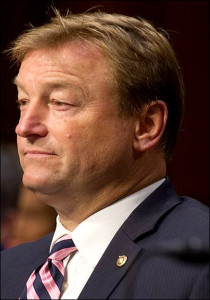By Jim Ellis
April 28, 2017 — Democrats face a major problem in the 2018 Senate races that they have no ability to solve. Forced to defend 25 of the 33 in-cycle seats, not counting the new 2017 Alabama special election, there simply aren’t enough viable Republican conversion targets to yield a legitimate run for the majority.Even in what should be their top conversion target, the Nevada race where GOP Sen. Dean Heller is seeking his second term, the Democrats do not yet have a viable candidate. This week, businessman Steve Cloobeck, who has the ability to self-fund a Silver State campaign, announced that he would not run.
And then, in a move that perplexed the Democratic leadership, Cloobeck went a step further and publicly endorsed Sen. Heller for re-election. While professing not to agree with Heller on core issues, Cloobeck says he appreciates “his (Heller’s) businesslike approach to politics and legislation.”
Reps. Dina Titus (D-Las Vegas) and freshman Ruben Kihuen (D-Las Vegas) have been mentioned as possible Heller challengers, but their actions do not suggest that either is contemplating building a serious statewide campaign.
According to the Federal Election Commission first quarter 2017 financial disclosure filing, Rep. Titus raised only $73,104, and has $274,715 cash-on-hand. Rep. Kihuen’s totals were a bit low even for a freshman building a first re-election campaign. He obtained just over $310,000 and has $276,485 reported as a cash-on-hand figure. If either were planning to enter this statewide contest the pair would certainly be far more active on the fundraising trail.
As we know, Nevada is a key national swing state, but one that sways greatly based upon turnout. When voter participation is high, Democrats tend to win, although Sen. Heller’s 46-45 percent win in the 2012 presidential election year is an exception to that pattern. When it is low, Republicans do better. The latter statement was particularly true in 2014 when turnout dipped precipitously and Republicans swept the ballot from the governor’s race through the state legislature.
When Sen. Harry Reid was last elected in 2010, defying most polling that suggested he was in danger of losing, more than 721,000 voters cast ballots, meaning a turnout rate of 64.4 percent when matched against the registration list. With just under 140,000 more voters on the rolls for the 2012 presidential contest, almost 81 percent of the entire registered universe voted in that election.
Two years later, in the GOP’s 2014 landslide, Democratic participation fell into the doldrums. Turnout dropped more than 45 percent from the 2012 totals, thus leading to the Republican sweep.
In this past November, with the voter rolls swelling with more than 250,000 new registrants, turnout again climbed for the presidential vote. In this election, the registered participation factor was more than 76 percent. With Democrats obviously returning to the polls in a major way after an abysmal participation record two years earlier, the party carried the state for Hillary Clinton, elected Democratic former Attorney General Catherine Cortez Masto to the US Senate, and converted two Republican US House seats.
Even with the solid rebound performance in the most recent election, strong Democratic politicians are not stepping up to challenge Sen. Heller. It is still early in the cycle, but the longer Heller can bolster his present standing, the tougher it becomes to unseat him. And, if they can’t win one of their few legitimate 2018 targets, then the chances of Democrats actually losing Senate seats in the first mid-term election for a new president of the opposite party becomes a real possibility.

